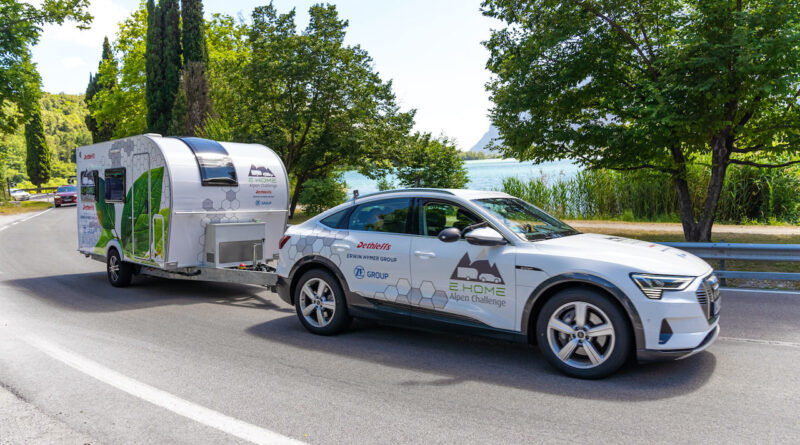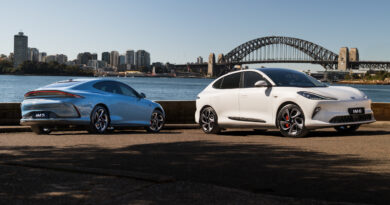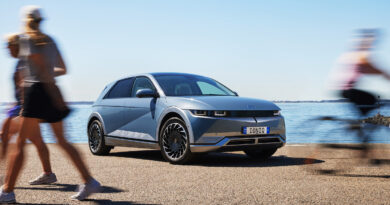EV towing solution: power-up your caravan
Concerns about the towing ability of electric vehicles may have been solved by a German caravan company.
Dethleffs has developed a self-powered electric caravan and proved the concept by towing it more than 380km across the Swiss Alps behind an Audi e-Tron Sportback.
Developed in conjunction with the Erwin Hymer Group and major supplier ZF, the E.Home is fitted with two 40kWh lithium-ion batteries, two offset e-motors with 30kW outputs and an integrated gearbox.
It can be recharged at a fast-charge DC rate up to 50kW.
COMPLETE GUIDE: Towing a caravan or trailer with an EV or hybrid
Total weight of the drivetrain is currently 600kg, but the production goal is 400kg.
The caravan powers its two wheels via a control unit that administers appropriate amounts of thrust, rather than relying on the tow vehicle to drag it along. On downhills energy is regenerated into the battery packs.
“In contrast to a conventional outfit, you can’t feel much of the load of the trailer,” ZF development engineer Emanuel Pfiffner said.

“During acceleration, for example when joining a motorway, the towing vehicle does not have to additionally set the mass of the caravan in motion and behaves almost like a solo vehicle thanks to the supporting drive.
“But during normal driving, the E.Home outfit is also much more stable and safe to drive, thanks to the lower centre of gravity and the drive. And on downhill stretches or when braking, the caravan no longer runs towards the vehicle because the outfit is automatically stretched apart to provide a significantly safer driving experience.”
The drive unit can also aid manoeuvring of the caravan at a camp site via smartphone control.
Same EV range, even with a caravan
The 386km route from the Dethleffs factory in the German Allgäu region across the Brenner Pass to Lake Garda was just 7km shy of the e-Tron’s claimed 393km range.
It is popular with caravanners and was selected to prove that the electric drive of the E.Home can compensate for the higher energy consumption caused by towing and that the towing vehicle can achieve its usual range even with a caravan in tow.
“The ranges of the current electric vehicles and the current status of the European charging station infrastructure are designed for solo vehicles and do not take into account the requirements of towing operation, for example with a caravan,” explains Dethleffs managing director Alexander Leopold.

“Dethleffs has always seen itself as a caravanning pioneer. We have therefore identified the challenges of electromobility early on and – together with our partners – are developing solutions that will make this individual way of travelling possible in the future.”
After six hours and 12 minutes and 386 km, the E.Home combo reached the town centre of Riva on Lake Garda without any recharging along the way. The charging indictator showed some remaining energy in the battery packs of both vehicles.
The overall result: 82kWh of energy consumed by the towing vehicle and 74kWh by the caravan; 11kWh of energy was regenerated in the towing vehicle and around 6kWh in the caravan.
The E.Home is designed as a variable, single-axle trailer using a modular, box-shaped base frame, a drawbar with standard tow hitch and an over-run braking device and a central rubber suspension axle.
The positioning of the axle and batteries ensures the weight of the centrally arranged electric motors and the battery packs is evenly distributed, ensuring the support load and payload distribution correspond to that of a conventional caravan.
The E.Home is not yet eligible for type approval according to the current European approval regulations. A vehicle category for ‘trailers with drive’ has not yet been defined.
The additional weight of the drive raises questions, such as how to account for the weight of the drive components in the permissible towing capacity of the towing vehicle and the driving license category required for towing driven trailers.
The system can also be used by ICE-powered vehicles and lower their fuel consumption rate.




